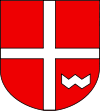Sienno, Masovian Voivodeship
| Sienno | ||
|---|---|---|
| Village | ||
| ||
 Sienno | ||
| Coordinates: 51°5′22″N 21°28′36″E / 51.08944°N 21.47667°E | ||
| Country |
| |
| Voivodeship | Masovian | |
| County | Lipsko | |
| Gmina | Sienno | |
| Population | 1,000 | |
| Website | http://www.sienno.pl/ | |
Sienno [ˈɕennɔ] is a village in Lipsko County, Masovian Voivodeship, in east-central Poland. It is the seat of the gmina (administrative district) called Gmina Sienno.[1] It lies some 15 kilometres (9 mi) south-west of Lipsko and 130 km (81 mi) south of Warsaw.
The village has a population of 1,000.
History
The History of Sienno dates back to at least the 14th century, in 1375AD was built the first wooden church, at that time it belonged to the parish in Chotcza. Between 1431 and 1442 Dobisław z Oleśnicy, the lord of Sienno, was built of a church of brick in the Gothic style and it was consecrated by Cardinal Zbigniew Oleśnicki.
In the 16th century the church was replaced by Sebastian Sienieński as a calvinist church. Catholics reconsecrated the building at the beginning of the 18th century. It was partially destroyed by fire in 1879 and again during World War I. Rebuilt in the interwar period, it is today an example of Gothic architecture. Five Gothic paintings on Panel with from 1460AD are located in Medieval Art Gallery in the National Museum in Warsaw.
Sienno received city rights in approx. 1430, and has lost them after the January uprising in 1869. Sienna residents participated in the January uprising and in the resistance during World War II. There was a battler 7 km to the North of the village. This was the place of death of Colonel Dionizy Czachowski.
Sienno represented a significant concentration of the Jewish population. The first small group mentioned in 1576. Municipality of about 100 people was founded in the 18th century, in 1921 in Sienno about lived 735 Jews. There was here a wooden synagogue from the 18th century and the Jewish cemetery. Both objects were destroyed by the Germans. In Sienno by was the ghetto, in which Germans came together ok. 2,000 people before deportation to the German Treblinka extermination camp in October 1942. Rabbi in Sienno was for some time, Abraham Joshua Heschel, the famous Jewish philosopher, theologian, and writer.
People of Sienno
Sienno was the home town of prominent members of Dębno coat of arms including among others, Bishop of Krakow Cardinal Zbigniew Oleśnicki (later Archbishop of Gniezno), Jakub z Sienna. Coat of Arms for Sienno is the coat of arms of the Dębno family, which, inter alia, includes the Oleśnicki's and Sienieński's families.
- John from Sienno, founder of Zloczow 1442
- Thomas from Sienno, Bishop
- James from Sienno, Bishop
- Jan Sienieński, voivode of Podolskie Voivodeship,
- Jan Sienieński, Castellan of Małogoszcz,
- Dobiesław Sienieński, Canon of Gniezno, Dean of Kielce and Radom
- Jakub Sienieński – lecturer at the Racovian Academy.
- Zbigniew Sienieński, Castellan
- Zbigniew Oleśnicki Cardinal
- Baltazar Opec, writer
- Włodzimierz Sedlak, priest, professor
- Abraham Joshua Heschel, the Jewish philosopher and theologian, Rabbi in Sienno
- Lucjan Fornalski, landowner, owner of a nearby farm Coins (Narożniki)
Gallery
- Sienno
- Sienno
- Church in Sienno
 Saint Sigismund church in Sienno
Saint Sigismund church in Sienno.jpg) Catholic cemetery
Catholic cemetery.jpg) Jewish Cemetery
Jewish Cemetery- Sienno
References
- ↑ "Central Statistical Office (GUS) – TERYT (National Register of Territorial Land Apportionment Journal)" (in Polish). 1 June 2008.
External links
- Jewish Community in Sienno on Virtual Shtetl
Coordinates: 51°5′22″N 21°28′36″E / 51.08944°N 21.47667°E
